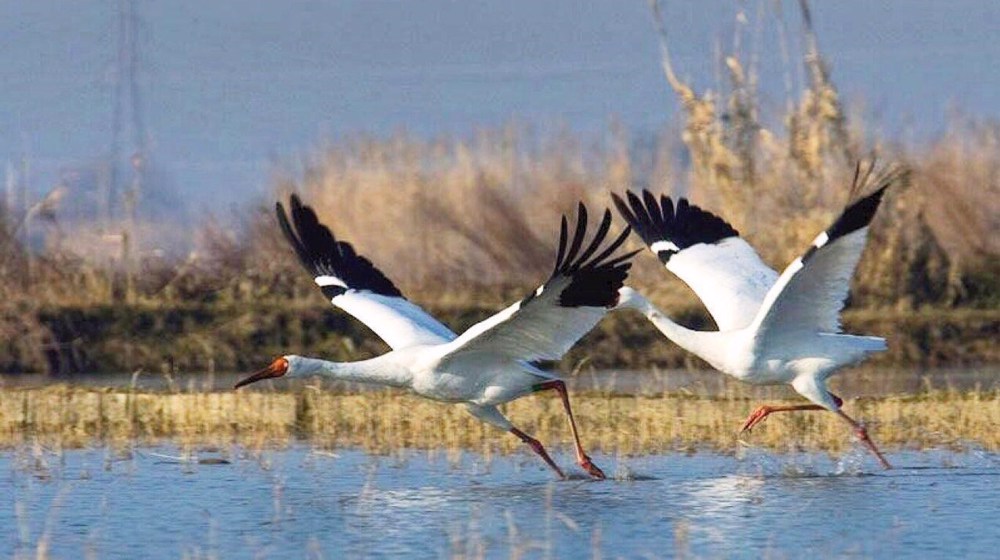‘Omid’, last surviving Siberian crane, leaves Iran after wintering with ‘Rouya’
By Maryam Qarehgozlou
Omid, a male Siberian crane known for being the only remaining crane of the western population, started his journey back to Siberia from northern Iran on Sunday, this time with a would-be mate Rouya, raising hope for the revival of the sharply dwindling species.
According to the Department of Environment (DoE) in northern Mazandaran province, the two Siberian cranes began their long and perilous flight from Fereydunkenar wetland to Uvat in western Siberia.
Omid arrived in Iran on October 27 and after 130 days of wintering in northern Iran's wetland, it left the resort for Siberia accompanied by Rouya who spent 34 days with him,” Ataollah Kavian, the Mazandaran DoE chief, was quoted as saying by Tasnim News agency on Sunday.
Omid which means ‘hope’ in the Persian language, has spent winters in Iran consecutively for the past 15 years even after he lost his mate Arezoo (meaning ‘wish’ in Persian).
Siberian cranes are believed to be profoundly loyal to their partners and perennially monogamous birds, and if one of them dies for some reason, the surviving crane rarely chooses a new partner.
In late January, Rouya, a captive-bred crane, was introduced by the Cracid & Crane Breeding and Conservation Center (CBCC) in Belgium to Omid.
Rouya, meaning ‘dream’ in Persian, was kept in a cage-like structure near Omid’s habitat and gradually introduced to the male Siberian crane.
Observing the birds’ behavioral changes closely, experts decided to release Rouya to Omid’s habitat five days later and after years of celibacy the male crane began to sing to court Rouya, a glimmer of light at the end of the tunnel, for conserving the critically endangered species.
Keramat Hafezi, a member of the Iran Bird Registration Committee, said last week that the two cranes were getting along well and that evidence suggested they would migrate together.
“Omid and Rouya are together day and night, feed perfectly in their habitat, fly and sing together and will evidently migrate together,” Hafezi said.
He described the situation as “excellent”, saying their migration route both inside Iran and outside the country will be closely monitored by local and international environmental bodies.
Hassan Akbari, the deputy chief of Iran’s Department of Environment, said on Sunday that the two cranes will fly over the provinces of Mazandaran, Gilan and Ardebil, towards Azerbaijan.
“They will probably rest at the first stopover site in Azerbaijan on their flyway and then travel along the Volga River in Russia to Kazakhstan, and in case everything goes well, they will stay at a wetland in this country to replenish their energy and fuel up for the next stage of their journey,” Akbari said, according to IRNA news agency.
Eventually, he added, they will fly along the Ob River in Russia and wing their way towards their final destination in western Siberia.
The third and most threatened species of cranes in the world usually spend the summers in Russia and winters in China, Iran, and formerly in India.
Being highly dependent on wetlands, the Siberian crane normally takes a 5000-kilometer flight for wintering in its wetland habitats.
In recent decades, small populations of Siberian Cranes in West and Central Asia have almost disappeared. The only viable population of this species is now found in eastern Asia, which migrates 5,000 km from the Yakutian tundra of Russia across highly developed eastern China to winter at Poyang Lake in the mid-Yangtze River Basin.
Since Omid is the only migrating bird left of his western flock, environmental bodies are attempting to help conserve the endangered bird species by making its habitat a safe place for him to spend the winter, and helping him find a new partner.
Illegal poaching and habitat loss caused by human-driven factors and drought spells are among the main reasons pushing this species to the brink of extinction.
“Environmental experts hope that Omid and Rouya succeed and finish their long, grueling journey and return to Iran the next year, but we should not build up high expectations,” Akbari said.
“Nonetheless, the Department of Environment makes great efforts to safeguard the [western] Siberian cranes’ population and stabilize its flight path.”
Israeli comptroller blasts regime for botching protection during wartime Iranian retaliation
VIDEO | Israel's Gaza, West Bank crimes
Iran, China, Russia reassert closure of Tehran’s nuclear restrictions
Qatar warns Israel's ceasefire violations threaten Gaza truce
Rights experts demand UEFA member associations boycott Israeli football
Iran relies on fossil fuels for 92% of its electricity generation: Official
Russia will strike back instantly if Europe provokes conflict: Putin
Iran tells The Hague unilateral sanctions are ‘crimes against humanity’













 This makes it easy to access the Press TV website
This makes it easy to access the Press TV website